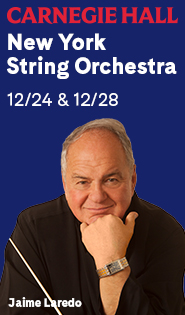The Orchestra Now mirrors our time with 1930’s rarities at Carnegie Hall
A pandemic, a gilded age, an economic depression, a war—the 1920’s and ‘30s hold up a “distant mirror” to our time. But now it’s a funhouse mirror, where everything is in a different order, and nobody knows the outcome.
That was the subtext of the program by The Orchestra Now conducted by Leon Botstein at Carnegie Hall Thursday night, with the tongue-in-cheek title “New Voices from the 1930s.”
Yes, the music of 20th-century composers William Grant Still, Carlos Chávez, Witold Lutosławski and Karl Amadeus Hartmann may be new to many present-day listeners’ ears. But Thursday’s selection of pieces also caught each of these worthies at a moment when he was at least something of a new kid on the block.
That may be a stretch with Still, who was 40 when he composed the tone poem Dismal Swamp, which led off the concert by the graduate-student ensemble from Bard College (where Botstein is also president). Also, Still has benefited lately from a renewed interest in African-American composers, so he’s become more familiar than the others.
In 1935, as now, the black experience in America was a current topic. Inspired by a poem by his wife, Verna Arvey, Still looked historically at the swamp from the point of view of an escaped slave: a creepy, malodorous place that also offered protection and the hope of freedom.
The piano soloist, sort of, in Still’s piece was Frank Corliss, a veteran pianist and coach who is also director of the Bard College Conservatory of Music. Apparently out of a combination of professional courtesy and the convenience of using the stage setup for the piano concerto to follow, Corliss sat front and center to play what was essentially an orchestral piano part, artfully adding chordal punctuation and some bubbling figures to the swampy ooze.
That ooze was evoked, at some length, by a Rite of Spring-like high bassoon over a growl of woodwinds and by slithering, bluesy passages for strings, before a brass interjection drove the music to an animated conclusion. Under Botstein’s direction, the ensemble played accurately and with fine touches of phrasing and dovetailing.
Next it was the turn of the indefatigable pianist Gilles Vonsattel to sit at the big Steinway and fire off Carlos Chávez’s extravagantly notey Piano Concerto. Despite the first movement’s colorful scoring and distinctively Mexican syncopated-waltz rhythms, the absence of this piece from concert programs today was understandable: it is a beast to play, and the musical rewards seemed meager by comparison.
Nevertheless, Vonsattel achieved some impressionistic effects and dark dialogue with the orchestra in the slow movement, and danced over the keys in the capricious finale. Taking a bow after the piece’s brassy conclusion, the pianist couldn’t quite suppress a palms-out gesture that seemed to say, “Well, anyway, now you’ve heard Chavez’s Piano Concerto.”
For immediate audience appeal, the winner Thursday night was Lutosławski’s concise Symphonic Variations of 1936-38, in which the 20-something composer charmingly blurred the piece’s passacaglia-style outline, sending new settings and timbres tumbling after each other for nine kaleidoscopic minutes before finishing big with his original flute theme in the brass. The young players clearly relished the score’s effects, from percussion-driven tuttis to ghostly shivers in the strings.
The image of desperate times in the distant mirror became most explicit in Hartmann’s Symphony No. 1, “Essay for a Requiem,” composed in 1935-36 and revised at the end of World War II. In the first movement, “Misery,” empathic poems from Walt Whitman’s Leaves of Grass, set in German translation and intoned affectingly by mezzo-soprano Deborah Nansteeel, alternated with colossal orchestral outbursts that seemed to embody the arrogance of power.
A brief second movement, “Spring,” set Whitman’s classic elegy “When lilacs last in the dooryard bloom’d,” first to murmured fragments in the orchestra, then to a pulsating crescendo as the singer unleashed the power of her ivory-toned top voice. In the orchestra-only central movement, “Theme with Four Variations,” the Mahlerian concept of the whole work was epitomized in ominous marches, gem-like moments for string quartet and celesta, dire bass drum strokes and trumpet calls, and strange, uncanny music-box passages.
Nansteel sustained long lines in her lowest register over a dark woodwind accompaniment for most of the fourth movement, “Tears.” Whitman’s ghost-story text unfolded amid low string sonorities and moaning woodwinds, with just one forte outburst for singer and orchestra in the middle. The symphony closed in a kind of prayer for the souls of the dead titled “Request,” set in Sprechstimme (between speech and singing) over pianissimo bass drum rolls and muted brass, with one pleading crescendo at the end.
Though hardly an audience-pleaser like the Lutosławski, Hartmann’s uncompromising evocation of a dark time in human history had an undeniable impact, thanks to Nansteel’s restrained yet focused singing and the realization of its tenebrous score by Botstein and the players.
Incidentally, the concert’s user-friendly features included program notes on the music by student players, both printed and spoken from the stage, and a large, visually appealing “Concert Quick Guide,” reminiscent of the start-up card you get with your new computer, inserted in the traditional Carnegie Playbill. These extra efforts to engage the audience didn’t adversely affect anything, and no doubt were appreciated by many new listeners.


Posted May 18, 2022 at 8:54 pm by Phillip Holt
Thank you much for the enthusiastic description of the concert. I was invited but could not afford to travel from Maine to hear my granddaughter/concertmaster. She was as enthusiastic as you.